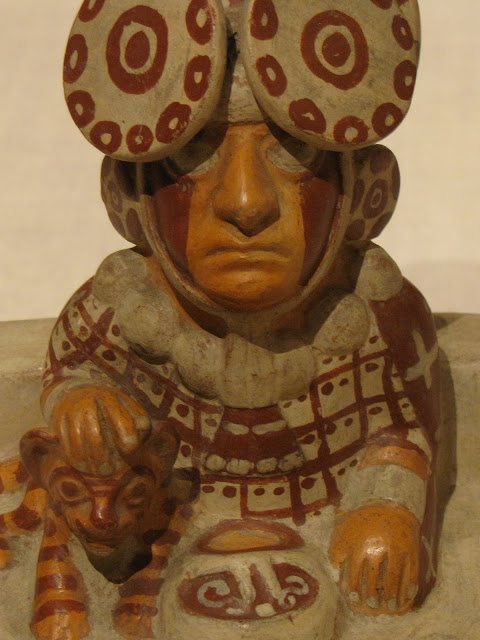Vessel in the Form of a Seated Ruler with a Pampas Cat, ceramic and pigment, 250/550 CE, Moche; North coast, Peru
Bowl Depicting a Mask (Possibly a Katchina), above an Abstract Bighorn-Sheep Head, ceramic and pigment, 1300/1400 CE, Four Mile Polychrome, White Mountain Redware; Cibola region, east-central Arizona, United States
Figure of a Woman in Ceremonial Dress, ceramic, 700/900 CE, possibly Totonac, Nopiloa; Veracruz, south-central Gulf Coast, Mexico
Seated Joined Couple, ceramic and pigment, 200 BCE/300 CE, Nayarit; Nayarit, Mexico
Miniature Mask, wood, gold foil, shell, pigment, and resin, 1300/1400 CE, possibly Mixtec; possibly northern Oaxaca, Mexico
Standing Figurine with Missing Leg, jade, 800/400 BCE, Olmec; Guerrero, Mexico
Vessel Depicting a Mythological Scene, ceramic and pigment, 600/800 CE, Late Classic Maya; Petén region, Guatemala
Portrait Vessel of a Ruler, ceramic and pigment, 100 BCE/500 CE, Moche; North coast, Peru
Head Fragments from Large Ceremonial Jars, ceramic and pigment, 700/800 CE, Tiwanaku-Wari; Pacheco, south coast, Peru
Hieroglyphic Panel, limestone, 650/800 CE, Late Classic Maya; Usumacinta River area, Mexico or Guatemala
Storyteller Figure, ceramic and pigment, 100/800 CE, Jalisco; Ameca Valley, Jalisco, Mexico
Vase of Seven Gods, Ah Maxam (active mid-late 8th century), ceramic and pigment, 750/800 CE, Late Classic Maya; vicinity of Naranjo, Petén region, Guatemala
Bowl Depicting a Hero-Hunter with a Heron Headdress, Bow, and Arrows, along with a Rabbit Hunter; ceramic and pigment (Classic Mimbres Black-on-white); Mimbres branch of the Mogollon; New Mexico, United States
Mosaic Disk with a Mythological and Historical Scene, turquoise, shell, and sandstone, 1400/1500 CE, Mixtec; Northern Oaxaca, Mexico
Mask from an Incense Burner Portraying the Old Deity of Fire, ceramic and pigment, 450/750 CE, Teotihuacan; Teotihuacan, Mexico
Ballcourt Panel, limestone, 700/800 CE, Late Classic Maya; possibly La Corona, Usumacinta River area, Guatemala
Figurine of an Aristocratic Lady, ceramic and pigment, 650/800 CE, Late Classic Maya, Jaina; Campeche or Yucatán, Mexico
Vessel of the Dancing Lords, Ah Maxam (active mid-late 8th century), ceramic and pigment, 750/800 CE, Late Classic Maya; vicinity of Naranjo, Petén region, Guatemala
Ritual Impersonator of the Deity Xipe Totec, ceramic and pigment, 1450/1500 CE, Aztec; possibly central Veracruz, Mexico
Female Figurine, ceramic and pigment, 500/400 BCE, Tlatilco; Tlatilco, Valley of Mexico, Mexico
Vessels, ceramic and pigment, Late Classic Maya, Mexico or Guatemala
Stela, limestone, 702 CE, Late Classic Maya; vicinity of Calakmul, Campeche or Quintana Roo, Mexico
Jar in the Form of a Standing Figure, ceramic and pigment, 100 BCE/500 CE, Moche; North coast, Peru
Female Effigy, terracotta and pigmented slip, 200/100 BCE, Chupícuaro; Guanajuato or Michoacán, Mexico
Standing Male Figure, ceramic and pigment, 650/800 CE, Late Classic Maya, Jaina; Campeche or Yucatán, Mexico
Pendant in the Form of a Figure, shell stone, silver, copper, and cotton, 400/800 CE, Tiwanaku-Wari; coastal Peru or highland Bolivia
Carved Vessel Depicting a Lord Wearing a Water-Lily Headdress, ceramic and pigment, 600/800 CE, Late Classic Maya, Chocholá; Yucatán or Campeche, Mexico
Portrait Vessel of a Young Man with a Scarred Lip, ceramic and pigment, 100 BCE/500 CE, Moche; North coast, Peru
Bowl Depicting a Harvest Dance, ceramic and pigment, 180 BCE/500 CE, Nazca; South coast, Peru
Portrait Vessel of a Man with a Cleft Lip and Tattoos, ceramic and pigment, 100 BCE/500 CE, Moche; North coast, Peru
Pedestal Bowl, ceramic and pigment, 1100/1300 CE, Coclé; possibly La Peña, Veraguas province, Panama
Vessel Depicting a Prisoner with Avian Captors, ceramic and pigment, 100 BCE/500 CE, Moche; North coast, Peru
Vessel in the Form of a Llama, ceramic and pigment, 100 BCE/500 CE, Moche; Chimbote, Santa Valley, Peru
Portrait Vessel of a Ruler, ceramic and pigment, 100 BCE/500 CE, Moche; North coast, Peru
Rattle in the Form of a Mythological Figure, ceramic and pigment, 650/800 CE, Late Classic Maya, Jaina; Campeche or Yucatán, Mexico
Vessel in the Form of a Royal Messenger, ceramic and pigment, 100 BCE/500 CE, Moche; North coast, Peru
Figure of a Standing Warrior, ceramic with pigment, 650/800 CE, Late Classic Maya, Jaina; Campeche or Yucatán, Mexico
Vessel in the Form of a Courtly Musician, ceramic and pigment, 100 BCE/500 CE, Moche; North coast, Peru
Vessel in the Form of a Warrior, ceramic and pigment, 100 BCE/500 CE, Moche; Chimbote, Santa Valley, north coast, Peru
Drinking Cup (Kero) with an Abstracted Masked Figure, ceramic and pigment, 600/1000 CE, Tiwanaku-Wari, Bolivia or Peru
Bowl Depicting a Swarm of Mice, ceramic and pigment, 180 BCE/500 CE, Nazca; South coast, Peru
Double Pendant in the Form of a Mythical Caiman, gold with plaster restoration of boar tusks, 800/1200 CE, Coclé; Coclé province, Panama
Vase of Seven Gods, Ah Maxam (active mid-late 8th century), ceramic and pigment, 750/800 CE, Late Classic Maya; vicinity of Naranjo, Petén region, Guatemala

Mantle (detail), camelid wool, 100 BCE/200 CE, Paracas Necropolis; Paracas peninsula, south coast, Peru
Double-Spouted Vessel Depicting Ritual Masks, ceramic and pigment, 180 BCE/500 CE, Nazca; South coast, Peru
Pedestal Bowl, ceramic and pigment, 700/1100 CE, Coclé; possibly Los Santos province, Panama
Jar in the Form of a Seated Figure, ceramic and pigment, 100 BCE/500 CE, Moche; North coast, Peru
All photos by author














.jpg)
































































